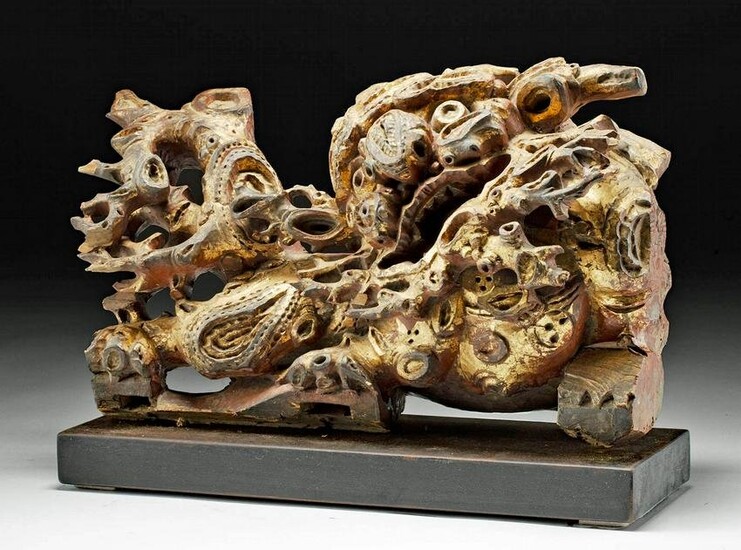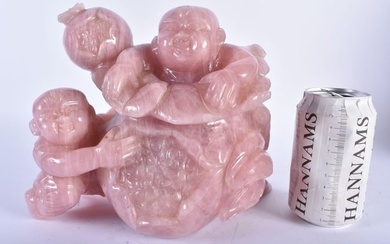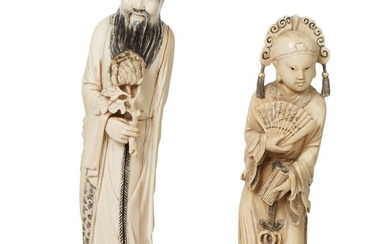Early 20th C. Chinese Qing Gilt Wood Panel Fu Lion
East Asia, China, late Qing Dynasty to early Republic Period, early 20th century CE. This is a lovely architectural panel carved with intricate overlapping and openwork layers in the form of a highly stylized fu lion highlighted in red pigments and gold gilt. The form is quite abstract: the lion is crouching facing to the right with the head curving back, the mouth open and surrounded by a flame-like mane, and raised circular eyes. At first glance this resembles knotted bark and branches of trees, so even if one cannot see the lion immediately, the eye is still captivated by the mesmerizing shapes. The wood is painted red - a lucky and symbolic color traditionally used on temples - and the verso contains a column of character script. This panel may have been positioned on the side of a building as a sacred guardian figure, and there are slots under the paws for the addition of tenons. Size: 16" L x 6" W x 10" H (40.6 cm x 15.2 cm x 25.4 cm); 11.75" H (29.8 cm) on included custom stand.
Lions were introduced to Chinese courts as early as the Han dynasty; however, most artists relied on second-hand sources for descriptions, resulting in very stylized figures that were often mistaken as dogs by western viewers. These fu lions, also known as foo lions or foo dogs, are the highly stylized representations of a spiritual lion guardians that protected sacred buildings, tombs, or palaces against evil spirits or people. They are usually presented in pairs outside an entrance to protect those within, representing the male and female as well as yin. Symbolically, the male fu lion protects the outside, and the female protects the inside of the dwelling. When portrayed together the male usually plays with a ball and the female plays with a cub.
Provenance: private Hawaii, USA collection; ex-M. Kobiashi collection, Hawaii, USA, 1960 to 2000
All items legal to buy/sell under U.S. Statute covering cultural patrimony Code 2600, CHAPTER 14, and are guaranteed to be as described or your money back.
A Certificate of Authenticity will accompany all winning bids.
PLEASE NOTE: Due to recent increases of shipments being seized by Australian & German customs (even for items with pre-UNESCO provenance), we will no longer ship most antiquities and ancient Chinese art to Australia & Germany. For categories of items that are acceptable to ship to Australia or Germany, please contact us directly or work with your local customs brokerage firm.
Display stands not described as included/custom in the item description are for photography purposes only and will not be included with the item upon shipping.
#168520
Condition Report: Layers of gilding were likely added or touched-up in modern times. Verso contains characters in black ink that are faint and indiscernible. Old iron nail fragment from original mounting protruding from verso. Chips and fading to paint and losses and chips to wood, especially on the tips of the mane and losses to paws. Great overall preservation and nice weathered patina.
View it on
Estimate
Time, Location
Auction House
East Asia, China, late Qing Dynasty to early Republic Period, early 20th century CE. This is a lovely architectural panel carved with intricate overlapping and openwork layers in the form of a highly stylized fu lion highlighted in red pigments and gold gilt. The form is quite abstract: the lion is crouching facing to the right with the head curving back, the mouth open and surrounded by a flame-like mane, and raised circular eyes. At first glance this resembles knotted bark and branches of trees, so even if one cannot see the lion immediately, the eye is still captivated by the mesmerizing shapes. The wood is painted red - a lucky and symbolic color traditionally used on temples - and the verso contains a column of character script. This panel may have been positioned on the side of a building as a sacred guardian figure, and there are slots under the paws for the addition of tenons. Size: 16" L x 6" W x 10" H (40.6 cm x 15.2 cm x 25.4 cm); 11.75" H (29.8 cm) on included custom stand.
Lions were introduced to Chinese courts as early as the Han dynasty; however, most artists relied on second-hand sources for descriptions, resulting in very stylized figures that were often mistaken as dogs by western viewers. These fu lions, also known as foo lions or foo dogs, are the highly stylized representations of a spiritual lion guardians that protected sacred buildings, tombs, or palaces against evil spirits or people. They are usually presented in pairs outside an entrance to protect those within, representing the male and female as well as yin. Symbolically, the male fu lion protects the outside, and the female protects the inside of the dwelling. When portrayed together the male usually plays with a ball and the female plays with a cub.
Provenance: private Hawaii, USA collection; ex-M. Kobiashi collection, Hawaii, USA, 1960 to 2000
All items legal to buy/sell under U.S. Statute covering cultural patrimony Code 2600, CHAPTER 14, and are guaranteed to be as described or your money back.
A Certificate of Authenticity will accompany all winning bids.
PLEASE NOTE: Due to recent increases of shipments being seized by Australian & German customs (even for items with pre-UNESCO provenance), we will no longer ship most antiquities and ancient Chinese art to Australia & Germany. For categories of items that are acceptable to ship to Australia or Germany, please contact us directly or work with your local customs brokerage firm.
Display stands not described as included/custom in the item description are for photography purposes only and will not be included with the item upon shipping.
#168520
Condition Report: Layers of gilding were likely added or touched-up in modern times. Verso contains characters in black ink that are faint and indiscernible. Old iron nail fragment from original mounting protruding from verso. Chips and fading to paint and losses and chips to wood, especially on the tips of the mane and losses to paws. Great overall preservation and nice weathered patina.







